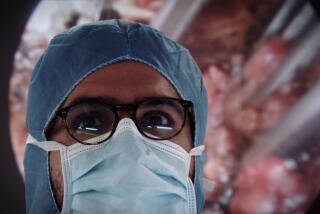The Language of Cells
- Share via
THE LANGUAGE OF CELLS:
Life as Seen Under the
Microscope
By Spencer Nadler
Random House
200 pages, $24.95
*
When a doctor chooses to work in the lab instead of the examination room, some physicians say, it’s probably because he doesn’t have a good bedside manner. That’s a bit unfair, especially to someone like Spencer Nadler. He’s a surgical pathologist with a poet’s heart--a delver into the mysteries of disease who has spent his career peering into a microscope without losing his passion for human stories.
Technological breakthroughs made pathology an exciting field when he started in the 1960s, but Nadler says, “I have missed, too, what I still remember of the quiet heroics of everyday people who, in the strange confines of a hospital, struggled in bloody arenas to maintain their dignity. To that end, after so many years, I still seek out patient bonding.”
“The Language of Cells” is the result of that search, a collection of compelling, vivid essays about the people, and their illnesses, whom Nadler has encountered “during my infrequent excursions into clinical life.”
Sensitive, often charming, always informative, these essays give us portraits of how patients’ lives and their cells have been affected by cancer, obesity, sickle cell anemia, Alzheimer’s disease, Parkinson’s disease and the inevitable onset of aging and death.
Early in the book we meet Hanna, a breast cancer patient who uses her imagination to fight the disease and who has a determination that mirrors her malignancy’s:
“ ‘Why don’t they just die? ... Don’t cancer cells self-destruct?’
‘Apparently not. Cancer somehow disables the program. The cells forget how to die.’
‘Well, so do I,’ she says, a faint smile stealing across her face.”
Not a minor bit of irony, this is a metaphor of how a patient’s drive for survival resembles the behavior of cells. In fact, it is an important theme throughout the book, showing us how the cellular side of medicine is intimately related to people’s lives.
Moments of poignant realization abound in “The Language of Cells,” and for the light it sheds on the humanity of disease, it should be found on every physician’s shelf right alongside the books on gross anatomy.






